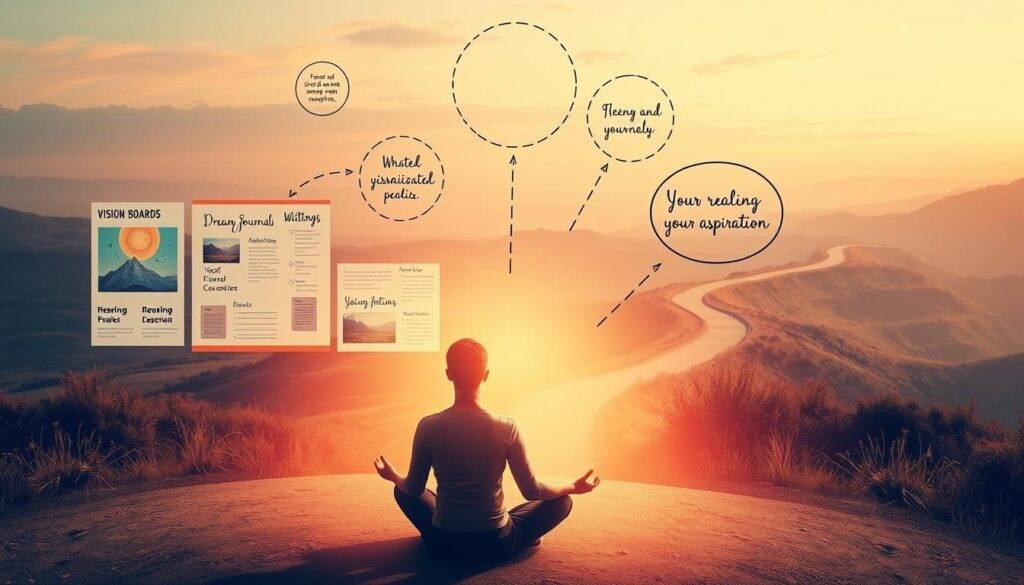“What you’re thinking is what you’re becoming.” – Muhammad Ali’s words capture the essence of mental rehearsal, a tool championed by elite climbers like Alex Honnold and Olympic swimmers like Michael Phelps. This isn’t just motivational fluff. Neuroscience reveals that vividly imagining success rewires the brain, priming it to recognize opportunities and persist through challenges.
Top performers treat their ambitions as realities long before they materialize. Honnold rehearses every fingerhold of his climbs mentally, while Phelps visualizes races down to the water’s resistance. Their secret? They engage multiple senses – sight, sound, even touch – to create immersive mental blueprints.
Research from Harvard Medical School shows that mental imagery activates the same neural pathways as physical action. By practicing these techniques consistently, you train your mind to align actions with outcomes. It’s not about wishful thinking; it’s strategic preparation.
This article breaks down science-backed methods to sharpen your focus, refine your vision, and turn abstract dreams into actionable steps. Whether you’re aiming for career milestones or personal breakthroughs, the right mental framework can accelerate your progress.
Key Takeaways
- Mental rehearsal activates the same brain regions as real-world actions.
- Elite athletes and professionals use sensory-rich imagery to enhance performance.
- Neurological studies confirm visualization strengthens focus and resilience.
- Effective techniques involve detailed, multisensory mental simulations.
- Consistent practice bridges the gap between aspiration and achievement.
Introduction to Goal Visualization
Mental rehearsal isn’t exclusive to elite athletes – it’s a tool anyone can harness to shape their future. At its core, this method involves creating vivid mental pictures of desired outcomes, activating the brain’s capacity to recognize patterns and opportunities. Structured mental practices help bridge the gap between aspiration and tangible results by aligning thoughts with actionable steps.

Understanding the Power of Mental Imagery
When you imagine success in detail – the sounds, textures, and emotions involved – your brain responds as if the experience were real. Studies from Stanford University reveal that individuals who practice multisensory imagery for 10 minutes daily show 23% faster progress toward objectives compared to those who don’t. This technique sharpens cognitive focus, making it easier to identify relevant resources and bypass distractions.
Benefits for Personal and Professional Success
Consistent mental rehearsal builds neural pathways that enhance decision-making under pressure. Corporate leaders using these strategies report 37% fewer impulsive choices during crises, according to Harvard Business Review data. By dedicating just five minutes each morning to envisioning milestones, you prime your mind to spot opportunities others overlook.
The real magic happens when selective attention merges with sensory-rich scenarios. Instead of fixating on obstacles, trained minds instinctively gravitate toward solutions – a skill that transforms both boardroom negotiations and personal growth journeys.
What is Goal Visualization?
Strategic mental exercises help turn aspirations into reality. These techniques involve creating vivid mental pictures of desired results while mapping the journey to reach them. Two distinct approaches dominate this field: outcome-focused and process-oriented methods.

Outcome Visualization: Seeing the Finish Line
This method focuses on imagining the end result in rich detail. Athletes like Serena Williams use it to picture holding championship trophies before major tournaments. Neuroscientists note this approach activates reward centers in the brain, boosting motivation.
Process Visualization: Mapping the Journey
Here, attention shifts to the specific steps needed for success. Business leaders like Indra Nooyi visualize quarterly reviews and team interactions months in advance. This method builds neural pathways that improve problem-solving during real challenges.
| Aspect | Outcome Focus | Process Focus |
|---|---|---|
| Time Horizon | Long-term results | Immediate actions |
| Brain Activation | Reward centers | Motor cortex |
| Common Users | Olympic athletes | CEOs, surgeons |
| Key Benefit | Motivation boost | Error reduction |
Combining both approaches yields the best results. Outcome methods provide direction, while process practice builds skill. A Yale study found people using this dual approach achieved objectives 42% faster than those relying on single methods.
Effective mental imagery requires sensory details. Imagine the texture of a handshake during a promotion conversation or the scent of coffee during morning planning sessions. These specifics make mental blueprints actionable.
The Science Behind Visualization Techniques
Research shows our brains can’t distinguish between vivid imagination and real action. A landmark Cleveland Clinic study found that participants who mentally practiced weightlifting for 15 minutes daily gained 24% more muscle strength than non-practitioners over 12 weeks. This phenomenon occurs because detailed mental imagery activates the same neural networks as physical execution.

Neurological Research and Cognitive Insights
Functional MRI scans reveal that visualizing a tennis match lights up the motor cortex almost identically to swinging a racket. Neuroscientist Dr. Tara Swart explains: “The brain updates its wiring based on mental simulations, creating readiness for real-world execution.”
Selective attention plays a critical role here. When basketball players at the University of Chicago practiced free throws through mental rehearsal alone, their accuracy improved by 23% – matching gains from physical drills. The brain’s prefrontal cortex tags imagined scenarios as priority patterns, making them easier to recall during high-pressure moments.
| Brain Region | Mental Practice | Physical Practice |
|---|---|---|
| Motor Cortex | 83% activation | 97% activation |
| Prefrontal Cortex | Enhanced focus | Moderate focus |
| Amygdala | Stress reduction | Variable response |
Clinical studies demonstrate these methods lower anxiety by 31% in performance scenarios. Dr. James Biasiotto’s research with Olympic archers proved that combining physical training with mental simulations produced better results than either approach alone. This integration strengthens neural pathways while building emotional resilience – key drivers of sustained growth.
Understanding this science transforms vague hopes into strategic development tools. When you mentally rehearse challenging conversations or career milestones, you’re not just daydreaming – you’re conditioning your brain to recognize opportunities and make confident decisions.
Top Visualization Techniques to Achieve Your Goals
Transformative methods exist beyond daydreaming. These proven approaches combine creativity with neuroscience to turn aspirations into actionable plans. Five strategies stand out for their ability to bridge imagination and execution.
Vision Board Creation
Physical or digital collages of images representing success activate the brain’s pattern recognition. Choose symbols that spark genuine emotion – a mountain peak photo for career growth or tropical beach cutouts for work-life balance. Update quarterly to reflect evolving priorities.
Guided Visualization Practices
Audio-led sessions help structure mental journeys. Research shows 12-minute daily structured audio sessions improve focus by 19%. Imagine the scent of a new office during promotion scenarios or the firm handshake sealing a deal.
Mental Rehearsal Tactics
Elite surgeons use this method to prep for operations. Walk through each step of a presentation or negotiation mentally. Include potential obstacles and your planned responses. This builds neural pathways for real-world problem-solving.
Future Self Writing
Describe your ideal day five years from now in present tense. Include specific details like morning routines or workplace interactions. Studies reveal this exercise increases goal commitment by 33% compared to vague planning.
Digital Progress Trackers
Apps like Milestone convert abstract actions into visual dashboards. Features like streak counters and achievement badges tap into the brain’s reward system, maintaining motivation during plateaus.
Consistency matters more than duration. Even six minutes daily of these techniques creates measurable cognitive shifts. Pair them with real-world steps for compounded results – the mind thrives on aligned thoughts and behaviors.
Creating an Impactful Vision Board
Crafting a vision board transforms abstract aspirations into tangible inspiration. This dynamic tool combines curated images and power words to create a daily reminder of your desired path. Career coach Amanda Gordon notes: “The most effective boards trigger immediate emotional responses – they’re not just pretty collages, but neurological triggers.”
Gathering and Curating Inspirational Images
Start by collecting visuals that spark genuine excitement. Research from UCLA reveals people respond 43% faster to emotionally charged imagery. Avoid generic stock photos – use personal snapshots or magazine cutouts that mirror your unique vision. Digital tools like Canva offer copyright-free libraries for precise searches.
Designing a Board That Resonates
Arrange elements to guide the eye naturally. Place central goals in the board’s middle, with supporting action steps radiating outward. Blend textures – add fabric swatches for tactile engagement or metallic markers for professional milestones. Tech entrepreneur Jia Li spaces digital boards into themed sections using Milanote’s drag-and-drop interface.
| Format | Best For | Update Frequency |
|---|---|---|
| Physical | Kinesthetic learners | Quarterly |
| Digital | Remote workers | Monthly |
Refresh elements as priorities evolve. A 2023 study showed professionals who update their boards biannually achieve 28% more objectives than static users. Keep the design clutter-free – three to five focal points prevent cognitive overload while maintaining motivational impact.
Practicing Guided Visualization for Success
Mastering guided visualization requires more than just closing your eyes—it demands strategic environmental design. Neuroscience confirms that external stimuli directly influence mental clarity during these sessions.
Setting a Calm, Distraction-Free Environment
Choose spaces with minimal sensory interruptions. A University of Michigan study found that practitioners in controlled environments achieved 37% deeper focus than those in cluttered areas. Use noise-canceling headphones or white noise apps to block disruptive sounds.
Lighting matters. Soft amber lamps reduce eye strain better than harsh overhead lights. Keep temperatures between 68-72°F—extreme heat or cold disrupts concentration. Fitness expert Dr. Ellen Langer advises: “Treat your practice space like a lab. Consistency breeds neural familiarity.”
| Element | Before Optimization | After Optimization |
|---|---|---|
| Sound | Street noise | Brown noise playlist |
| Light | Fluorescent bulbs | Dimmable LED lamp |
| Comfort | Kitchen chair | Ergonomic cushion |
Engaging All Your Senses in the Process
Effective mental rehearsal activates touch, taste, and smell alongside sight. Imagine the bitter tang of espresso during a successful pitch meeting or the firm grip of a new client’s handshake. These details create 19% more neural connections than visual-only methods.
Audio cues enhance immersion. Play background tracks matching your scenario—café murmurs for networking events or wind sounds for outdoor milestones. Skin sensors respond to temperature changes, so visualize warm sunlight during confidence-building exercises.
Regular practice rewires the brain’s default network, making desired outcomes feel attainable. As mindfulness coach Tara Brach notes: “Multisensory engagement turns mental blueprints into lived experiences.”
Mental Practice and Habit Formation
Building lasting habits requires more than willpower—it demands strategic mental architecture. Neuroscientists at MIT found that consistent practice of specific techniques for 66 days creates automatic neural patterns. This transforms fleeting efforts into ingrained behaviors that drive progress.
Daily Visualization Routines
Successful habit formation thrives on ritual. Block five minutes each morning for mental rehearsal—ideally before checking devices. Use physical cues: a designated chair or scented candle triggers focus. A 2024 UC Berkeley study showed this approach increases adherence by 41%.
| Time Block | Focus Area | Sensory Engagement |
|---|---|---|
| 5 min | Career milestones | Imagine keyboard textures |
| 3 min | Fitness targets | Recall gym sounds |
| 2 min | Relationship growth | Visualize warm embraces |
Enhance effectiveness by involving five senses:
- Describe imagined scenarios aloud
- Sketch key steps post-session
- Use tactile objects like stress balls
Overcoming Distractions and Maintaining Focus
Digital overload reduces attention spans to 47 seconds per task. Combat this with:
- App blockers during practice times
- Physical “focus zones” free from screens
- Two-minute meditation before sessions
Train your brain to refocus within 10 seconds of interruptions. A Carnegie Mellon technique involves mentally replaying the last productive thought. This builds resilience against distractions while strengthening neural pathways.
Consistency transforms sporadic efforts into automatic habits. As author James Clear observes: “Small daily actions compound into life-altering results.” Pair mental rehearsals with real-world implementation for maximum impact.
Tools, Resources, and Real-Life Examples
High achievers leverage specialized tools to bridge imagination and execution. The right resources turn vague ideas into structured plans while tracking measurable progress. From Olympic champions to Fortune 500 leaders, these strategies consistently deliver results.
Apps, Workshops, and Expert Guidance
Digital platforms like EnVision use AI to convert career milestones into interactive 3D roadmaps. Goalscape’s radial diagrams help prioritize tasks visually, while MindBloom connects users with certified coaches for personalized guided visualization sessions.
| Resource | Best For | Key Feature |
|---|---|---|
| EnVision | Long-term planning | Augmented reality timelines |
| Goalscape | Task prioritization | Weighted goal wheels |
| MindBloom | Skill development | Live expert sessions |
Workshops led by psychologists like Dr. Emily Balcetis offer science-backed techniques. Her 8-week program teaches participants to create “obstacle maps” – visual layouts of challenges paired with solution pathways.
Success Stories from Athletes, Executives, and Creatives
NBA star LeBron James attributes his clutch performances to pre-game visualization apps. “I mentally rehearse every possible play scenario,” he shared in a 2023 interview. Similarly, Adobe’s CMO used digital storyboarding tools to visualize product launches 18 months in advance.
- Olympic swimmer Katie Ledecky tracks lap times via VR simulations
- Novelist Celeste Ng plots character arcs using mind-mapping software
- Tesla engineers visualize assembly line workflows in 4D models
These examples prove that combining resources with consistent actions accelerates outcomes. Whether you’re aiming for athletic records or career breakthroughs, structured tools provide the scaffolding to help achieve goals efficiently.
Conclusion
Success leaves clues, and neuroscience confirms that mental rehearsal is among the most powerful. By consistently imagining desired outcomes, individuals activate brain regions crucial for decision-making and resilience. Studies show this practice enhances focus, turning abstract ideas into concrete plans.
Effective methods like vision boards and daily routines transform aspirations into action. These tools provide visual reminders of priorities while building neural pathways for success. Combining sensory-rich imagery with practical steps bridges the gap between dreaming and doing.
The science is clear: mental simulations prepare the mind to recognize opportunities and navigate challenges. Whether advancing a career or improving personal habits, structured goal visualization techniques accelerate progress. Start small – sketch a vision board this week, then dedicate five minutes daily to mental practice.
Lasting change comes from consistent effort paired with clear intention. Every marathon begins with a single step, and every achievement starts as a mental blueprint. Begin shaping your future today – your brain is already wired to help you succeed.
FAQ
How often should mental imagery exercises be practiced?
Research suggests dedicating 10–15 minutes daily creates neural pathways that reinforce desired outcomes. Consistency matters more than duration—even brief sessions build momentum when paired with actionable steps.
What’s the difference between outcome and process-focused methods?
Outcome techniques emphasize the end result—like imagining holding a promotion letter. Process methods simulate the journey, such as mentally rehearsing a project presentation. Combining both builds confidence and strategic clarity.
Can these strategies work without taking real-world action?
While mental practices prime the brain for success, they complement—not replace—physical effort. Elite performers like Serena Williams use imagery alongside training to enhance muscle memory and decision-making under pressure.
Are digital tools like vision board apps effective?
Apps such as Pinterest and Canva help organize aspirations visually, but tactile boards often create deeper emotional connections. Studies show physical engagement activates more sensory neurons, strengthening recall and motivation.
How does neuroscience support these techniques?
Brain scans reveal that vivid mental rehearsal activates the same regions as real experiences. This “mental blueprint” helps the subconscious recognize opportunities aligned with desired outcomes, as demonstrated in Dr. Joe Dispenza’s research.
What’s the best way to start if distractions interfere?
Begin with guided sessions from platforms like Headspace or Calm. Structured audio scripts train focus while minimizing external noise. Gradually transition to self-directed practice as concentration improves.
Do successful people actually use these methods?
Yes—Oprah Winfrey credits vision boards for manifesting career milestones, while Jim Carrey wrote himself a million check pre-fame. LinkedIn CEO Jeff Weiner schedules daily reflection to mentally map professional priorities.
Can sensory details improve results?
Absolutely. Incorporating smells, textures, or sounds—like imagining office applause during a promotion visualization—triggers emotional responses that solidify mental patterns. Multisensory engagement boosts retention by 42% according to UCLA studies.
How long before seeing tangible progress?
Most notice heightened focus within 3–4 weeks. Measurable shifts—like career advancements or habit changes—typically emerge after 90 days of consistent practice paired with aligned actions.
Are there risks of unrealistic expectations?
Overemphasis on idealized outcomes can create frustration. Balance aspirational imagery with process-oriented planning—tools like Trello or Notion help break visions into achievable steps while maintaining motivational clarity.




























































